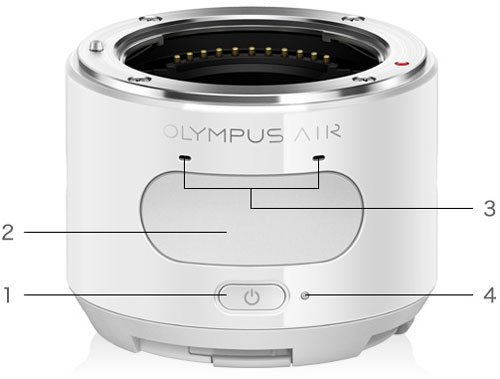
I stumble upon this thing today.
Could be a good (great?) camera platform for UAV.
What do you guys think?
Source: http://www.imaging-resource.com/PRODS/olympus-air-a01/olympus-air-a01A.HTM
More: Google: Olympus Air
============================================================
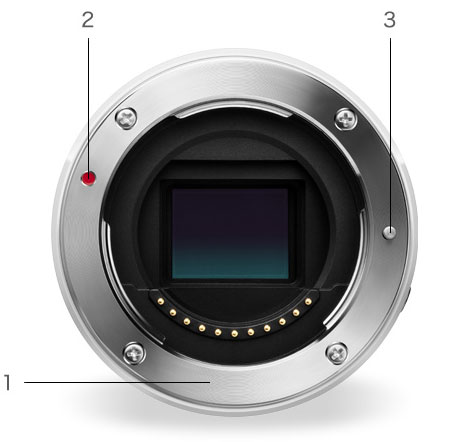
The front of the Olympus AIR A01 is pretty much all lens mount with the Micro Four Thirds bayonet flange (1), lens alignment mark (2), and locking pin (3) called out. You can also see the 4/3" sensor through the cover glass and the electrical lens contacts along the bottom.
Looking down at the top we can see a power switch (1), a large shutter button (2), stereo microphone ports (3), and a status LED (4). These minimal controls allow the AIR A01 to take quick snap-shots without the assistance of a mobile device.
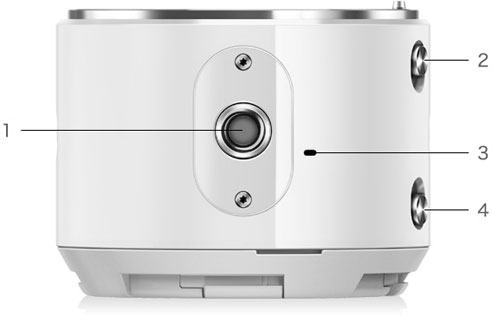
Looking at the bottom, we see a standard tripod socket (1), the lens release lever (2), a speaker port (3), and a release lever for the AIR's own mounting flange (4). Not shown is a pair of threaded mounting points, located on the left and right sides of the barrel, occupied by little button-head screws, to keep them pristine and clean until you want to use them to attach the AIR to something.
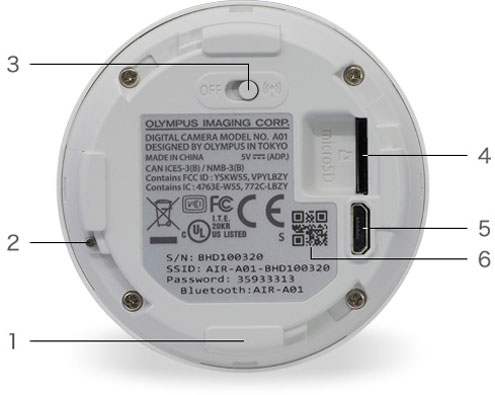
And finally on the back with the protective cover removed, we can see the accessory mount flange (1), accessory mount locking pin (2), wireless radio on/off switch (3), microSD card slot (4), micro USB port (5), and a QR code (6) along with Wi-Fi SSID, password and Bluetooth device name printed on the label.
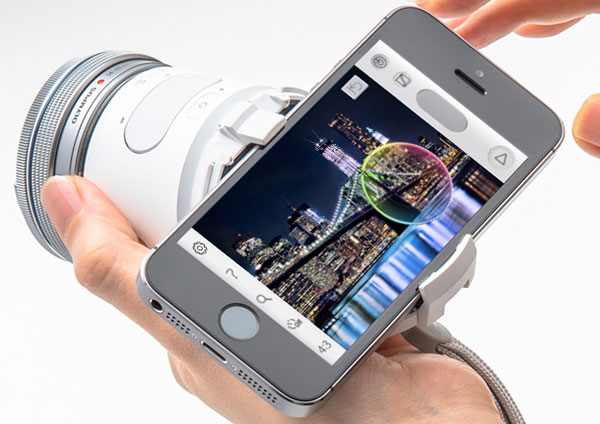
The Olympus AIR A01 includes an "AIR Coupler" accessory, which lets you mount a smartphone in landscape orientation at about a 45° angle. It supports a variety of smartphone sizes.
The product images above are all from Olympus. We normally replace the manufacturer's shots with our own once we have a camera in-hand, but in this case decided to leave the above, because they were so beautifully done, but also because the details are so much easier to see on a white body than the black one we received as an eval unit. (We were given a choice of white or black, but opted to go with black for improved "stealth" operation when shooting candids.) The product shots below are all our own, though.
Comments
I don't think the A01 electronic shutter will be any good for aerial mapping.
https://www.blackmagicdesign.com/products/blackmagicmicrocinemacamera
In principle, more pixels to work with means better compression efficiency. But what I suspect is happening is that most cheap 4K encoders today do a lot of shortcuts to be able to encoder 4K at all. Meaning they can do more real-time computations pr. pixels in 1080p then compared to 4K.
John, good points, but practice says otherwise when it comes to 100 vs 60mbps quality, e.g. Gh4 much higher quality. And this I can't agree with: "Having 4K compressed at the same bit-rate/pixel ratio as 1080p, will potentially lead to better results." (Although this obviously depends on the codec used.) See also discussion on RCG about upcoming DJI X5/X5R and (looks like) it's operation at 60mbps.
Anybody know if there are any gimbals suitable for this style of camera? I imagine they will be super compact. Attachment looks like it should be fairly simple.
At 100Mbit/sec (12.5MB/sec) even the best class 10 card will not be fast enough to store the video stream. The only class fast enough is the UHS Class 3 with a very limited selection of cards available. So there are some practical implications that has to be considered when selecting bit-rates.
And the bit-rate/quality ratio is not a linear thing. Once you get past the peak threshold there is exponentially less quality to gained from increasing the bit-rate.
Let's look at the numbers.
1080p60 = 124Mpixels/sec
2160p30 = 248Mpixels/sec
So there is a factor of 2 more pixels in 30fps 4K (2160p), compared to 1080p 60fps.
The prosumer AVCHD standard uses 28Mbit for 1080p60 video, and 28x2 = 56. So 60Mbit is not just a number picked out of thin air.
In addition, since the main principle behind mpeg compression is to look for visual similarities in the video frames, and efficiently represent those. Having more pixels in the video, means more data to work on that lead to more efficient compression. So, having 4K compressed at the same bit-rate/pixel ratio as 1080p, will potentially lead to better results.
Yuneec is also coming up with a camera similar to the E1, with true Panasonic Gh4 sensor and 100mbps throughput (vs the limited 60mbps of the Ambarella A9 behind the Z camera and the GP4). 4k with 60mbps is sort of a shame ... Will probably be more expensive though.
Exiting times ...
The Olympus AIR is a very good camera also thanks to the lenses.
But the Sony sensors is far ahead.
The QX1 has a sensor a bit dated but i thinks soon will be updated to the 24Mpix A6000 sensor ,
in this case the QX will be much greater than the Olympus.
I believe that the SONY choice is more conservative
ZCamera is supplier of the DJI Zenmuse X5 sensors?
I'm getting my Kickstarter version shortly. Not sure about retail.
-
1
-
2
of 2 Next